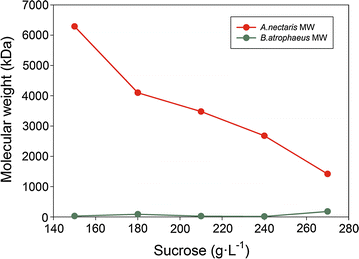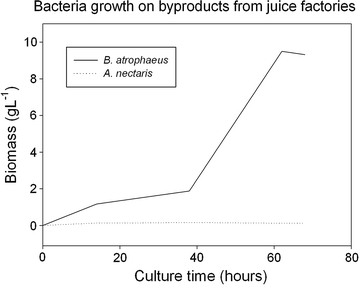Effect of bacteria type and sucrose concentration on levan yield and its molecular weight
- PMID: 28535808
- PMCID: PMC5442672
- DOI: 10.1186/s12934-017-0703-z
Effect of bacteria type and sucrose concentration on levan yield and its molecular weight
Abstract
Background: Levan has been traditionally produced from microorganism. However, there is a continuous effort in looking for new strains that improve levan production yield and uses alternative sugar sources for growth. Despite having a wide range of data about levan yield, there are not papers which allow controlling molecular weight, and that plays an essential role for further applications.
Results: The effect of the sucrose concentration on levan yield (and its molecular weight) from Bacillus atrophaeus and Acinetobacter nectaris (Gram positive and Gram negative respectively) was studied in this work. It was found that A. nectaris growth (from 3 to 1.5 g L-1 in 40 h) and its levan production (from 3 to 1.5 g L-1) decreases by increasing sucrose concentration (best results at a concentration of 120 g L-1) whereas B. atrophaeus growth (3.5 g L-1 in 30 h) and its levan production (also 3.5 g L-1) were not affected by modifying that parameter. Levan molecular weight from A. nectaris decreases by increasing sucrose concentration (from 8000 to 2000 kDa) whereas levan molecular weight from B. Atrophaeus remains always around 50 kDa. By performing a kinetic study, it was shown that A. nectaris growth follows a substrate-inhibition model, whereas Monod equation provided a good fit for B. atrophaeus growth. Finally, wastes from orange juice industry were used as a medium culture to cultivate those microorganism, obtaining good results with B. atrophaeus (growth 3 g L-1 in 30 h).
Conclusions: Levan production kinetics was determined and compared between different bacteria types.
Keywords: Byproducts; Kinetics; Levan; Molecular weight.
Figures







References
-
- Gupta SK, Pal AK, Sahu NP, Dalvi RS, Akhtar MS, Jha AK, Baruah SK. Dietary microbial levan enhances tolerance of Labeo rohita (Hamilton) juveniles to thermal stress. Aquaculture. 2010;306:398–402. doi: 10.1016/j.aquaculture.2010.06.008. - DOI
-
- Poli A, Kazak H, Gürleyendag B, Tommonaro G, Pieretti G, Öner ET, Nicolaus B. High level synthesis of levan by a novel Halomonas species growing on defined media. Carbohydr Polym. 2009;78:651–657. doi: 10.1016/j.carbpol.2009.05.031. - DOI
-
- Jathore NR, Bule MV, Tilay AV, Annapure US. Microbial levan from Pseudomonas fluorescens: characterization and medium optimization for enhanced production. Food Sci Biotechnol. 2012;21:1045–1053. doi: 10.1007/s10068-012-0136-8. - DOI
MeSH terms
Substances
LinkOut - more resources
Full Text Sources
Other Literature Sources
Molecular Biology Databases

